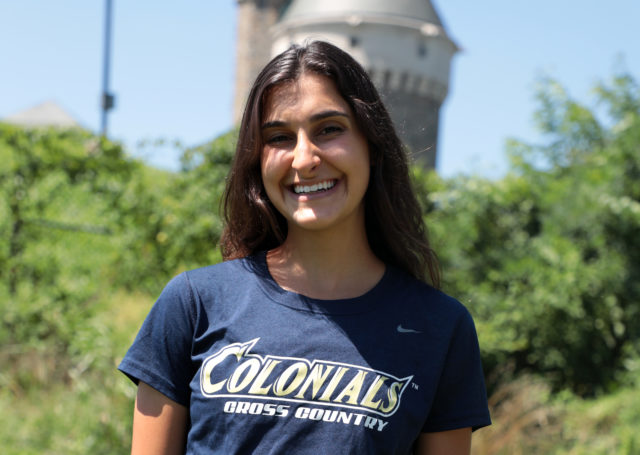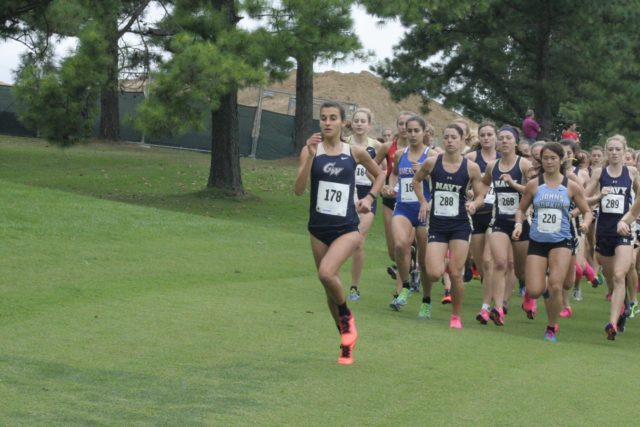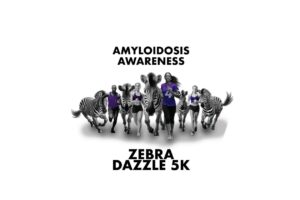
Miranda DiBiasio fell in love with running while she was in high school, relieved to find an activity that was so personally rewarding. Running allowed her to breathe, calm her nerves and find peace.
She didn’t feel as seasoned as other runners her age, and she was drawn to George Washington University, which was also growing — the Colonials were debuting track teams when she would start school. She could grow as a runner alongside a new team.
Throughout her time at GW, DiBiasio learned a lot about being a competitive runner. The track program demanded more time and energy than she had ever experienced, but she took it in stride. She quickly learned that it was no longer just about showing up for runs, it was about putting in the work off the field too — a hard lesson for a lot of runners to learn. This required more work on flexibility and a ton of work on strength to correct her form. She watched her diet like it was a religion.
In many respects, she sacrificed her soul for the sake of her sport. She had to get through all of this to progress. Running was so much more than just logging the miles.
DiBiasio didn’t flinch. She did the work, dedicated her time, energy and spirit and it began paying off.
“One of my most memorable moments was competing in the Atlantic 10 Championship for outdoor track,” she said of her sophomore year. “It was my first 10K, the longest distance we had, and being on a track felt so different. My excitement for that race was more than I had ever felt, and I just knew it would be my event.”
DiBiasio not only won the race but solidified her running career at GW. She won A10 titles twice in the 10k and once in the indoor 5k. By her senior year, DiBiasio was captain of the team, built a strong resume and was ready to carry her now deep-seated passion for running beyond college by studying exercise science in graduate school.
As she neared the finish line of her undergraduate career, her plans took an unexpected, though not entirely unpredictable turn. She suffered a serious stress fracture of her pelvis. With the can-do spirit of a passionate runner, DiBiasio saw this injury initially as nothing more than a setback and a challenge to overcome. With the promise of red-shirting during the rest of the fall season and applying to graduate school, there wasn’t an ounce of doubt that she would heal up and move on — just a blip on her radar.
But, things didn’t get better.
“The following year may have been one of the hardest of my life,” she said. “Before that injury, I had never known what it felt like to be truly sidelined and disconnected with the sport I loved, my teammates and my routine.”
Because of the severity of the injury, all activity was off limits, which turned DiBiasio’s world and routine upside down. Not only was she in severe physical pain, she was also struggling mentally… a lot.
The injury brought to the surface a slew of underlying issues that ultimately revealed that DiBiasio’s approach to running wasn’t as flawless as she believed.
It turns out many of the steps she had taken to be successful were actually harming both her body and soul. She had an unhealthy relationship with food and exercise, a prolonged absence of menstruation and decreasing bone health working underneath the surface of an apparently successful collegiate running career. Together, these three factors make up what is called the Female Athlete Triad, a medical condition observed in physically active females and it is sadly not uncommon in female distance runners.
According to the National Institutes of Health, women who participate in sports that emphasize athletics or leanness, such as ballet or running, the prevalence of secondary amenorrhea can be as high as 69 percent, compared with 2-5 percent in the general population.
“I found out I had osteopenia, the precursor to osteoporosis, at the age of 21. This was in part because I had what is called amenorrhea, or the absence of menstruation. My period was gone because I wasn’t taking in sufficient calories to balance my extreme activity level. This realization was terrifying for me. I planned to run for the rest of my life, but my bone density as a young adult could be compared to a 65-year-old woman.”
Focusing all her energy on recovering, DiBiasio worked with doctors, dietitians, psychologists, psychiatrists and physical therapists to begin the healing process. She also found critical support in two organizations, the Strong Runner Chicks and the Lane 9 Project — which focused on providing support, education and community to other runners going through the same experience.
Along with her team of medical professionals, these organizations were an instrumental part of her recovery and they gave her the opportunity to connect with other women who have struggled in similar ways. It took three of the hardest years of her life for DiBiasio to heal and restore a view of herself that was affirming. Rediscovery has meant keeping her diet and exercise routine balanced, taking rest days without guilt, eating a balanced diet and, perhaps more important, not feeling guilty about indulging in the foods and other passions she loves.
“The mission of these groups is to redefine what it means to be a female runner by changing the culture of distance running that often sends us messages that we must look a certain way to perform well. We need to amplify the idea that no one body shape or size equates to success, the importance of self-love and self-care, and sharing positive messages about food, body image and running.”
Fueled by her journey to recovery, DiBiasio started her own research-based online community tailored towards young female runners as her senior thesis in the spring of 2018. She named the community Striding for Balance because she believes balance is the key to life, no matter what discipline.
Although DiBiasio is taking a break from running, she is working on her biggest project yet — finding herself without running. Focusing on all the other qualities that make her who she is, she’s confident that she will one day run again, when she wants it to come back, rather than forcing it back into her life.
She is starting her second year in GW’s graduate program in exercise physiology, with hopes to make that her career, working with athletes and non-athletes alike to improve their health, well-being, athletic performance by using exercise as medicine.
“This line of work has also allowed me to integrate my passion for athlete health and to raise awareness about disordered eating in athletes,” she said. “I really enjoy working with athletes in general, but I believe it is especially rewarding to work with athletes and others who have struggled with similar things that I have. This could be injury, eating disorders, amenorrhea, osteopenia, or anything else. I think it is incredibly valuable to hear from people who have been through the experience before and can say with certainty, ‘You can and will get through this!'”
With a new relationship with running and herself, DiBiasio’s journey has been bumpy, to say the least.
“In hindsight this experience taught me more about myself than I had even known, and brought me to a place of true health.”

Recent Stories
Looking for our race calendar? Click here Submit races here or shop local for running gear
Zebra Dazzle 5k Walk/Run or 100 Bike over 30 Days
Join the Zebras for this Zebra Dazzle event for all fitness levels. The 5k Walk/Run has 2 options. You can participate as an onsite participant on 9/13 at Carter Barron in Rock Creek Park, NW Washington DC or as a
Hero Dogs 5K9
Hero Dogs Inc will host its 5th Annual 5K9 race at the Congressional Cemetery on Saturday, May 17th, beginning at 8 am. There will also be a 1K Fun Run. The 1K Fun Run will start at 8 am sharp






